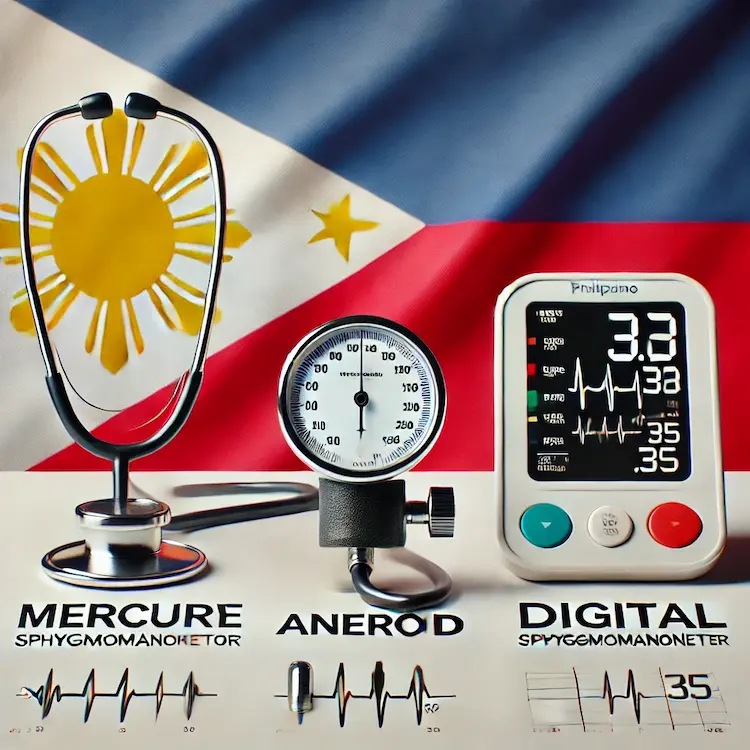High blood pressure is a growing concern in the Philippines, affecting millions of individuals. Regular monitoring can help prevent severe complications such as heart disease, stroke, and kidney failure. A best sphygmomanometer for home use, or blood pressure monitor, is essential for tracking blood pressure at home. But with so many options available, how do you choose the right one?
This guide will help you understand the different types of sphygmomanometers for home use, their advantages and disadvantages, and how to select the best one for home monitoring.
Why Home Blood Pressure Monitoring is Essential
Monitoring blood pressure at home offers numerous benefits:
- Early detection of hypertension: Regular checks help identify high blood pressure before complications arise.
- Better management of chronic conditions: Patients with hypertension or heart disease can track their progress more effectively.
- Reduction in ‘white coat syndrome’: Some people experience higher blood pressure in a clinical setting due to stress. Home monitoring provides more accurate readings.
- Cost-effectiveness: Frequent clinic visits can be expensive. A home monitor saves both time and money.
In the Philippines, where healthcare access varies across regions, home monitoring can bridge the gap, especially for those in rural areas.

Types of Sphygmomanometers
There are three main types of best sphygmomanometer for home use:
Mercury Sphygmomanometers
How it works: Uses mercury to measure pressure in a calibrated tube.
Pros:
- Highly accurate and considered the “gold standard.”
- Long lifespan and does not require recalibration.
Cons:
- Bulky and requires a flat surface.
- Risk of mercury exposure, making it less common in homes.
- Requires manual operation and a stethoscope.
Best for: Medical professionals and institutions needing high precision.
Aneroid (Manual) Sphygmomanometers
How it works: Uses a mechanical gauge and requires a stethoscope to listen to blood flow.
Pros:
- More affordable than digital monitors.
- No batteries or electricity are required.
Cons:
- Requires skill to use correctly.
- The gauge can lose calibration over time.
- Prone-to-user error, leading to inaccurate readings.
Best for: Trained individuals or healthcare professionals.
Digital Sphygmomanometers
How it works: Uses electronic sensors to detect blood pressure and displays readings on a screen.
Pros:
- Easy to use, making it ideal for home monitoring.
- Available in wrist and upper-arm models.
- Some models store previous readings for trend tracking.
Cons:
- Can be less accurate if not used properly.
- Batteries or charging required.
- Wrist models can be more prone to errors compared to upper-arm models.
Best for: best sphygmomanometer for home use, especially those without medical training.
Comparing Different Sphygmomanometers
| Feature |
Mercury |
Aneroid (Manual) |
Digital |
| Accuracy |
⭐⭐⭐⭐⭐ |
⭐⭐⭐⭐ |
⭐⭐⭐ |
| Ease of Use |
⭐ |
⭐⭐ |
⭐⭐⭐⭐⭐ |
| Portability |
⭐ |
⭐⭐⭐ |
⭐⭐⭐⭐ |
| Maintenance |
⭐⭐⭐⭐ |
⭐⭐⭐ |
⭐⭐ |
| Best For |
Hospitals, Clinics |
Healthcare Professionals |
Home Users |

Factors to Consider When Choosing a Home Blood Pressure Monitor
-
Accuracy
- Check if the monitor is clinically validated by organizations like the Philippine Society of Hypertension or the American Heart Association (AHA).
-
Cuff Size
- A poorly fitted cuff leads to inaccurate readings. Measure your arm circumference before buying.
-
Ease of Use
- Digital monitors are user-friendly, while manual options require training.
-
Memory and Connectivity
- Some digital models store readings and sync with apps for long-term tracking.
-
Budget
- Prices in the Philippines range from ₱1,000 ($20) for basic models to ₱5,000 ($100) for premium features.
How to Use a Blood Pressure Monitor Correctly
- Sit in a comfortable chair with your feet flat on the floor.
- Rest your arm on a table at heart level.
- Wrap the cuff snugly around your upper arm (or wrist, depending on the model).
- Relax for 5 minutes before measuring. Avoid caffeine, smoking, or exercise 30 minutes prior.
- Press start (for digital monitors) or pump the cuff (for manual devices).
- Record the reading and compare it with previous measurements.
Blood Pressure Trends in the Philippines
- According to the Philippine Heart Association, 1 in 4 Filipino adults has high blood pressure.
- Hypertension is the leading cause of stroke in the country.
- In rural areas, lack of healthcare access makes home monitoring crucial.
- The rise of telemedicine services allows patients to share readings with doctors remotely.
Conclusion
Choosing the right best sphygmomanometer for home use depends on your needs, budget, and ability to use it correctly. Digital monitors are the best option for most home users due to their convenience, while professionals may prefer aneroid or mercury devices for higher accuracy. Regular monitoring can help Filipinos take control of their health, prevent complications, and reduce healthcare costs.
Key Takeaways
- Home monitoring helps detect hypertension early and manage chronic conditions.
- Digital monitors are the best for home use, while manual options require training.
- Cuff size, ease of use, and accuracy are key factors in choosing a monitor.
- Filipinos benefit from home monitoring due to healthcare accessibility issues.
- Follow correct measurement techniques for accurate readings.
Actionable Recommendations
- Buy a clinically validated digital blood pressure monitor.
- Measure blood pressure at the same time daily for consistency.
- Track readings and consult a doctor if measurements are consistently high.
- Adopt a healthy lifestyle with a low-sodium diet and regular exercise.

